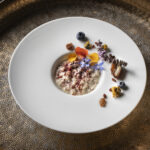Crystal-clear focus, fiery drive – the Pitta type lives life in the fast lane. But what happens when the inner fire no longer drives, but burns out? Ayurveda shows ways of managing energy without burning out. If you understand your Pitta characteristics, you can consciously cultivate them – and live life with a cool head.
The most important facts in brief:
- Fiery transformation: Pitta dosha represents the fire element in the body and controls metabolism, digestion and mental acuity.
- Characteristic traits: Pitta types are determined, analytical and decisive, but tend to be perfectionist and irritable when imbalanced.
- Balancing diet: Cooling, sweet and bitter foods such as cucumbers, leafy vegetables and coconut water harmonize the pitta dosha.
- Calming practices: Gentle yoga variations, cooling breathing exercises and regular breaks help to dissipate excess heat.
- Daily routines: A structured daily routine with conscious periods of rest and time spent in nature helps to balance the inner fire.
Contents
- What constitutes pitta dosha?
- How can you recognize a Pitta type in everyday life?
- Which stress factors increase pitta dosha?
- Pitta: Ayurveda nutrition tips
- Yoga and breathing exercises for increased Pitta
- Mixed types: Vata-Pitta or Pitta-Kapha?
- Routines suitable for everyday use for energy management
- Balance Pitta type at the Ayurveda Resort Mandira
- Frequently asked questions
What constitutes pitta dosha?
In Ayurvedic understanding, pitta represents the combination of the elements fire and water. This combination creates a transformative force that is responsible for metabolic processes and digestion. The fiery Pitta dosha controls all transformation processes in the body. On a mental level, pitta gives determination, assertiveness and sharp judgment.
According to Ayurvedic texts, there are five subtypes of Pitta: Pacaka, Ranjaka, Sadhaka, Alocaka and Bhrajaka, which control various processes in the body such as digestion, blood coloration, mental functions, vision and skin health.
Find your Dosha type
Unsure which dosha type you are? With our detailed test you can determine your individual constitution and receive tailored recommendations for your balance.
How can you recognize a Pitta type in everyday life?
In discussions, Pitta types convince through logical argumentation and objectivity. In a professional environment, they like to take on leadership roles and are characterized by their strategic planning and decisiveness. They work in a structured, efficient and solution-oriented manner.
In personal relationships, Pitta-dominant people value clarity and directness. They express their opinions openly and bluntly, which can sometimes be taken as criticism.
Physical signals
The typical Pitta physique is athletic and of medium stature with well-defined muscles. Scientific studies show that Pitta types have higher haemoglobin and red blood cell levels compared to the other dosha types. The skin is prone to redness, freckles and is sensitive to sunlight. Penetrating eyes and an intense gaze are also characteristic. The digestive system works efficiently, but can be prone to heartburn or irritable bowel symptoms when stressed.
Pitta types often have warm skin and tend to sweat, even in moderate temperatures. Their metabolism works quickly and efficiently, which results in a good appetite and rapid digestion. However, if there is an imbalance, this heat can get out of hand and lead to inflammation, skin rashes or digestive problems.
The energy level of Pitta people is generally high and consistent. They have a persistent capacity and can concentrate on a task for a long time. Fatigue often only becomes noticeable once a project has been completed, which can lead to phases of exhaustion if the limits of one’s own resilience are not recognized in time.
Character traits
Pitta types strive for perfection and set high standards – for themselves and others. They have a pronounced decisiveness and goal orientation. If there is an imbalance, perfectionism can turn into an addiction to criticism. The natural directness is then perceived as impatience or irritability.
The intellect of Pitta-dominant people is sharp and analytical. They grasp complex relationships quickly and develop logical solutions to problems. This ability makes them excellent strategists and planners who can keep a cool head even under pressure.
Pitta personalities value order and structure in their environment. They organize their work processes efficiently and expect the same from others. Their strong sense of justice allows them to stand up for their convictions, sometimes with an intensity that can overwhelm others.

Which stress factors increase pitta dosha?
Pitta dosha is particularly unbalanced by heat, time pressure and confrontation. Intense competition and performance situations can overstimulate the inner fire and lead to emotional overheating. Excessive self-criticism and the urge for perfection also increase the pitta imbalance.
Irregular meals or skipping meals can lead to noticeable energy fluctuations and increased irritability in Pitta types. Hunger additionally activates the inner fire, which can affect emotional stability. Regular food intake is therefore particularly important.
The summer months with their heat pose a particular challenge for Pitta types. In order to keep a cool head despite the heat, cooling measures and sufficient breaks are particularly helpful. Intense physical exertion can also generate excessive heat in the body and unbalance the Pitta dosha.
Pitta: Ayurveda nutrition tips
A balanced diet is the key to harmonizing the pitta dosha. Cooling, calming foods can reduce excess fire and provide more inner balance. Regular food intake is particularly important, as hunger increases pitta energy and can lead to irritability.
Prefer sweet, bitter and astringent flavors that have a cooling effect. Easily digestible, fresh dishes with moderate seasoning are ideal. Avoid spicy, sour and salty foods, on the other hand, which can fuel the inner fire and lead to digestive problems.
The method of preparation plays an important role for Pitta types. Steamed and steamed dishes are better tolerated than fried or spicy dishes. The temperature of the food is also crucial – lukewarm to cool meals calm the pitta dosha, while food that is too hot can intensify it.
Find out more about Pitta nutrition
Which foods are good for Pitta types – and which should be avoided? You can find out all this and more in our guide.
Yoga and breathing exercises for increased Pitta
Gentle yoga styles without pressure to perform – such as yin or restorative yoga – are particularly suitable for Pitta types. Cooling sequences such as the moon salutation and exercises during the cooler times of the day help to reduce excess heat. Avoid intense sweating and make sure you breathe calmly and evenly.
Supported poses such as Balasana (child’s pose) or Paschimottanasana (forward bend) promote grounding and withdrawal. They calm the nervous system and guide the gaze inwards – ideal for letting go of emotional irritability and tension.
The same applies to breathwork: cooling instead of activating. Techniques such as Chandra Bhedana (moon breathing) or Shitali Pranayama reduce the inner heat. Deep abdominal breathing with prolonged exhalation also strengthens the parasympathetic nervous system – this has a balancing effect and promotes mental serenity.
Relaxation exercise for in between
Sitali breath for cooling moments: Roll your tongue into a tube (or place your tongue slightly behind your slightly open lips). Breathe in slowly through this “cooling channel”, close your mouth and breathe out through your nose. Repeat this 5-10 times whenever you feel heated or stressed.
Mixed types: Vata-Pitta or Pitta-Kapha?
Most people are not pure Dosha types, but have combinations. Vata-Pitta types combine the creativity and agility of Vata with the determination and focus of Pitta. This combination produces a dynamic, adaptable personality, but one that can be prone to restlessness and overwork if both doshas are out of balance.
Pitta-Kapha types combine the constancy and patience of Kapha with the assertiveness and ambition of Pitta. This combination creates a stable, reliable foundation with the necessary energy for change. Imbalances can lead to a mixture of stubbornness and irritability, which can be challenging both for those affected and for those around them.

Routines suitable for everyday use for energy management
A clearly structured daily routine with consciously planned breaks helps Pitta types to regulate inner heat. Balance is particularly important at lunchtime and in the evening: a quiet lunch break, going to bed early before 10 pm and a gentle start to the day with meditation, stretching and a nutritious breakfast create inner stability.
Targeted breaks and cool surroundings
Short moments of relaxation such as deep breaths by an open window, a cool glass of water or quiet meditation help you to stay focused and calm. A pleasant room temperature and regular ventilation also help to cool you down.
In the warmer months of the year, spending time in nature is particularly beneficial – such as walks in the forest or time by the water. Light clothing made of cotton or linen in colors such as blue or white also supports well-being. After demanding phases, conscious regeneration is crucial – preferably without digital stimuli.
Creative aids for inner peace
Gentle music and creative activities such as painting, gardening or writing can gently channel Pitta energy – provided they are practiced without pressure to perform. Spontaneous music-making or handicrafts also promote emotional balance.
Cooling essential oils such as sandalwood, rose or jasmine have a calming effect in scented lamps or as drops on a handkerchief. A relaxing evening ritual with a lavender foot bath, meditation or inspiring reading helps you to let go of the day and prepares your body and mind for a restful sleep.
Harmonize Pitta Dosha – completely individually
Experience how individually tailored Ayurvedic treatments can harmonize your Pitta dosha. Our holistic treatments offer the perfect balance of relaxation and regeneration.
Balance Pitta type at the Ayurveda Resort Mandira
At the Ayurveda Resort Mandira, you will experience holistic care that is specially tailored to the needs of Pitta types. Our individually designed treatments combine traditional Ayurvedic knowledge with modern therapeutic approaches. The tranquil surroundings of the Styrian thermal spa region provide the ideal setting to rediscover your inner balance and recharge your batteries.
Frequently asked questions
What should a Pitta type not eat?
Pitta types should avoid spicy, acidic, salty and very hot foods. These include chili, pepper, citrus fruits, fermented products, alcohol, coffee and fried foods. These intensify the inner fire, promote irritability and can lead to digestive problems, skin problems or inflammation.
How can a Pitta type lose weight?
Pitta types lose weight best with regular, unavoidable meals that are cooling and easy to digest. Bitter vegetables, sweet fruit and steamed dishes are ideal. Excessive ambition should be avoided – moderate exercise, stress regulation and sufficient sleep support healthy weight loss.
How can a Pitta type deal with acute stress situations?
Cooling breathing techniques such as Sitali or Chandra Bhedana help Pitta types with acute stress reactions. Short breaks, walks in nature or calming herbal teas also help to reduce stress. It is important to reduce internal pressure and consciously avoid physical and mental overheating.
Cover image: © jozefklopacka – stock.adobe.com; Image 1: © sepy – stock.adobe.com; Image 2: © Framestock – stock.adobe.com



